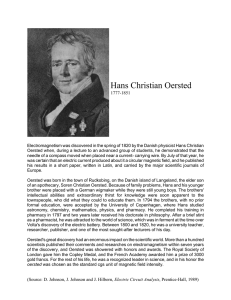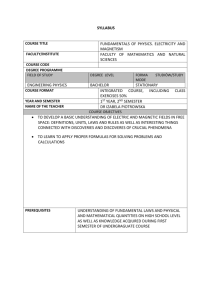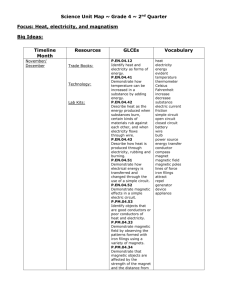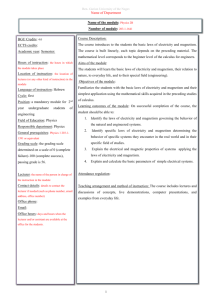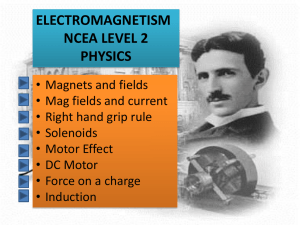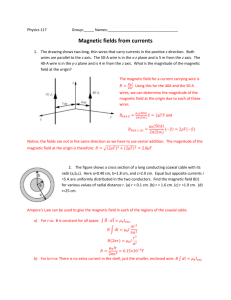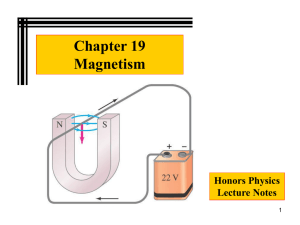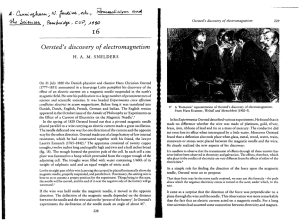Oersted's Experiment - Brittany Krutty's Teaching Portfolio
advertisement
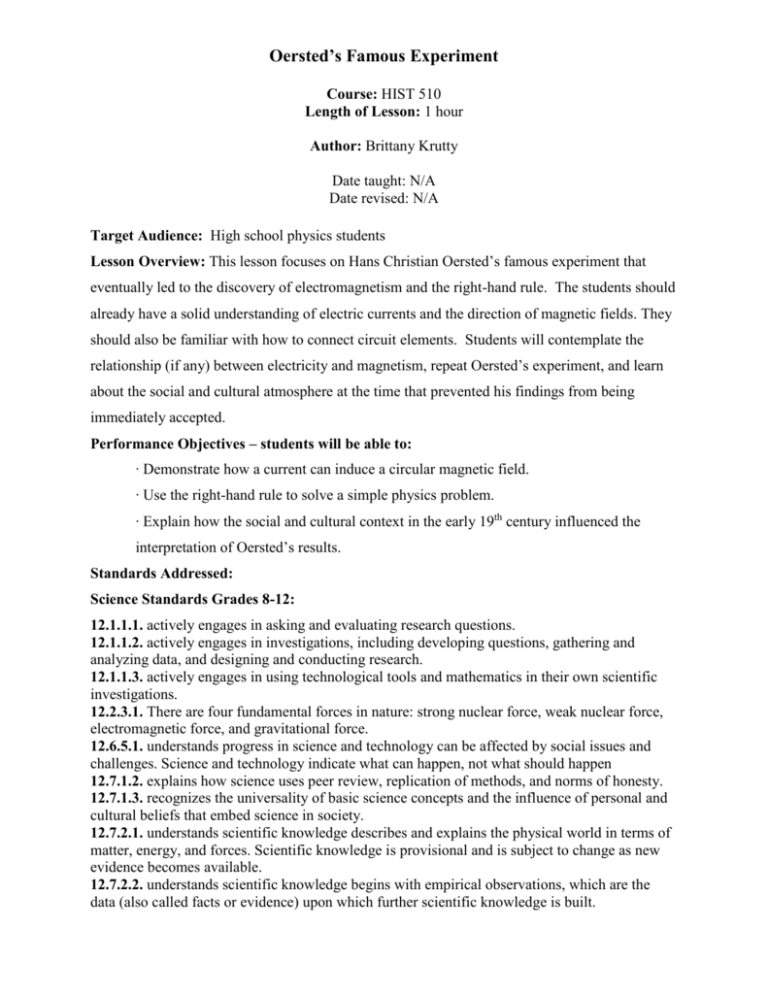
Oersted’s Famous Experiment Course: HIST 510 Length of Lesson: 1 hour Author: Brittany Krutty Date taught: N/A Date revised: N/A Target Audience: High school physics students Lesson Overview: This lesson focuses on Hans Christian Oersted’s famous experiment that eventually led to the discovery of electromagnetism and the right-hand rule. The students should already have a solid understanding of electric currents and the direction of magnetic fields. They should also be familiar with how to connect circuit elements. Students will contemplate the relationship (if any) between electricity and magnetism, repeat Oersted’s experiment, and learn about the social and cultural atmosphere at the time that prevented his findings from being immediately accepted. Performance Objectives – students will be able to: ∙ Demonstrate how a current can induce a circular magnetic field. ∙ Use the right-hand rule to solve a simple physics problem. ∙ Explain how the social and cultural context in the early 19th century influenced the interpretation of Oersted’s results. Standards Addressed: Science Standards Grades 8-12: 12.1.1.1. actively engages in asking and evaluating research questions. 12.1.1.2. actively engages in investigations, including developing questions, gathering and analyzing data, and designing and conducting research. 12.1.1.3. actively engages in using technological tools and mathematics in their own scientific investigations. 12.2.3.1. There are four fundamental forces in nature: strong nuclear force, weak nuclear force, electromagnetic force, and gravitational force. 12.6.5.1. understands progress in science and technology can be affected by social issues and challenges. Science and technology indicate what can happen, not what should happen 12.7.1.2. explains how science uses peer review, replication of methods, and norms of honesty. 12.7.1.3. recognizes the universality of basic science concepts and the influence of personal and cultural beliefs that embed science in society. 12.7.2.1. understands scientific knowledge describes and explains the physical world in terms of matter, energy, and forces. Scientific knowledge is provisional and is subject to change as new evidence becomes available. 12.7.2.2. understands scientific knowledge begins with empirical observations, which are the data (also called facts or evidence) upon which further scientific knowledge is built. 12.7.2.3. understands scientific knowledge consists of hypotheses, inferences, laws, and theories. 12.7.2.4. understands a testable hypothesis or inference must be subject to confirmation by empirical evidence. 12.7.3.1. demonstrates an understanding of the history of science. Lesson Bibliography: Dimitar G Stoyanov 2009 Eur. J. Phys. 30 641. doi: 10.1088/0143-0807/30/3/021 "EE-6 Magnetic Fields About Currents." University of Kansas. Web. 6 Mar. 2011. <http://www.physics.ku.edu/~physics/dept/demo/eandm/EE/EE-6.pdf>. Gregory, Frederick. "An Era of Many Forces." Natural Science in Western History. Boston, MA: Houghton Mifflin, 2008. 331-37. Print. "Hans Christian Oersted." MAGCRAFT® Brand Neodymium Rare Earth Magnets. National Imports LCC, 2007. Web. 06 Mar. 2011. <http://www.rare-earth-magnets.com/t-hans-christianoersted.aspx>. "Lesson Plan: Electricity and Magnetism." Google Docs. Web. 06 Mar. 2011. <http://docs.google.com/viewer?a=v&q=cache:vhQQQKXa3BgJ:www.uwyo.edu/scipossesupport/ Lesson%2520Plans/Fun%2520with%2520Electricity/Lesson%25202/LP%2520%2520Electricity%2520and%2520Magnetism%2520%2520Lesson2.doc+Lesson+Plan:+electricity+and+magnetism+~100+min&hl=en&gl=us&pid=bl &srcid=ADGEEShH9wkTjUijvYIPyYAOPWlayrg7y_OkXBW82_djXbU7CNOVVpZsn4JMGxq T_eJTi1xM8IXsHnEzXY-DIc5YyMFbGaL3ok-3nskGPKzvhMMD5OAP5xqSJBFwmIZMSNzyps2_ppb&sig=AHIEtbQ90fUqnbsA1IbRuogfTQPMUNloA>. "Free AutoCAD Tutorials : Looking at 3D in AutoCAD 2010." Tutorials, AutoCAD Photoshop - Artist Portfolio. Web. 06 Mar. 2011. <http://www.we-r-here.com/cad/tutorials/level_3/3-3.htm>. Materials: For each student: Pencil and paper For each lab group of 2-3 students: 1 9-volt battery 1 switch 1 resistor 2 conducting wires Safety Considerations: Be sure that students are using the materials appropriately. Do not allow students to continue the experiment if they are mistreating the materials. Follow proper lab behavior rules. Five-E Plan Engagement Time: 15 minutes What the teacher will do What the teacher will say Probing/eliciting questions Specific possible student responses 1. Give students the pre-quiz and allow 3-5 minutes 1. Think back to previous lessons. 1. 1. for them to complete it. 2. Engage the class in a discussion of electricity and magnetism and remind them of previous lessons. 2. Today we’re going to use what we already know about electricity and magnetism. 3. Briefly review the history of electricity and magnetism, leading up to Hans Christian Oersted’s experiment in the 19th century. 3. (See Oersted’s History Part 1 below) 4. Have the students draw their predictions of Oersted’s results on a piece of paper. 4. Draw a picture of the experiment as you understand it. 2. What are some of the forces we have learned about so far? 2. Gravity, electricity, magnetism, normal, friction, etc. In which direction does From the positive positive electric terminal of a battery current flow? to the negative terminal In which direction does From the north pole a magnetic field move? of the magnet to the south pole 3. What are some of the things Oersted may 3. Earth’s magnetic have had to take into field, other sources of account in his electrical or magnetic experiment? fields, magnitude of the current, etc. If you were one of Oersted’s students, Various answers. would you have been convinced by the results of his experiment, whatever those results may have been? Why? 4. What do you think happened? Draw your prediction on a piece of paper with several different compass needle positions. 4. Compass needles deflected in a circle, deflected in straight lines radially outward from the wire, not deflected at all, etc. Exploration Time: 15 minutes What the teacher will do What the teacher will say Probing/eliciting questions Specific possible student responses 1. Explain the experiment and draw the circuit diagram on the board (see below). 1-2. Here is what you 1-2. What direction is will be doing: create the current flowing? a circuit with the battery, wires, and switch. Use the 1-2. From the positive terminal of a battery to the negative terminal 2. Supervise as students perform the experiment. Have them draw or describe their results on paper. compass needle to figure out which way north is, and hold the wire directly above the compass in a north-south direction. Flip the switch so that the current is flowing through the wire. Try this with the current flowing the other way, and with the wire beneath the magnet. Draw or describe your results on paper. How can you make the current flow the opposite direction? Turn the wire around, change the circuit by switching the wires connected the positive and negative terminals, etc. What happens to the compass needle at each point? Various answers. Students should draw or describe their results on paper. Explanation Time: 30 minutes What the teacher will do What the teacher will say Probing/eliciting questions Specific possible student responses 1. Ask a few volunteers to draw their results on the board. 1. I need a few volunteers to draw their results on the board. 1. What happens to the compass needle at each point? 1. Various responses. Student’s drawings should be similar. 2. Discuss with the class the experiment’s implications for the relationship between electricity and magnetism. 2. Electromagnetism is defined as the fundamental relationship between electrical and magnetic fields, or the magnetism produced by an electric current. A moving electric field creates a magnetic field that rotates around it. 2. Are electricity and magnetism related? How? 2. Yes. The electric current creates a magnetic field around it, which deflects the compass needle. How does Earth’s magnetic field affect the results? If the wire were perpendicular to the compass needle, the needle wouldn’t be deflected at all. 3. Describe the social 3. (See Oersted’s and cultural History Part 2 below.) environment, including Oersted’s contemporaries, that prevented his 3. If you were another scientist in Oersted’s time, would you have been convinced by his experiment? 3. Various answers. findings from being immediately accepted. 4. Teach the class the right-hand rule and use it to solve a few simple problems. 4. Oersted’s discovery of electromagnetism eventually led to the development of the right-hand rule. When you wrap your hand around the wire with your thumb in the direction of positive current, your fingers point in the direction of the magnetic field. 4. (Draw on board) If I pass a current through the wire in this direction and place a compass needle here, in which direction will the needle point? 4. Students will give the direction the needle should point according the righthand rule. Elaboration Time: 15 minutes What the teacher will do What the teacher will say Probing/eliciting questions Specific possible student responses 1. Ask probing questions to expand upon Oersted’s findings. Have groups of 3-4 students choose one of the experiments you talk about (including Faraday’s experiment, described below) to perform during the next lesson. 1. Oersted’s experiment was just one way to test this new principle of electromagnetism. 1. What are some other ways you might test the connection between electricity and magnetism? 1. See if you can create an electric field from a magnet, use a coil of wire instead of a straight wire, use iron filings, etc. Could you create a magnet using electricity? How? Yes. Put a wire inside a coil of wire, etc. Could you create electricity using a magnet? How? Yes. Move magnets to change the electric field, etc. 2. If time permits, briefly describe Faraday’s experiments and his discovery of induction. 2. (See Oersted’s History Part 3 below) 2. If you were a scientific contemporary of Oersted and Faraday’s, would you be convinced by their experiments, or would you side with 2. Various responses. Ampère? Evaluation Time: 5 minutes What the teacher will do What the teacher will say Probing/eliciting questions Specific possible student responses 1. Give students the post-quiz and allow 3-5 minutes for them to complete it. 1. Please answer all the questions; I want to see what you have learned and what we still need to go over. 1. 1. Oersted’s History Part 1 (Before the experiment) Hans Christian Oersted was a Danish physicist and chemist who lived from 1777-1851. His father was a pharmacist, so he was exposed to science at an early age. At the University of Copenhagen, he majored in philosophy and science, two subjects that were much more closely related in those days. Up until about the 17th and 18th centuries, electricity was a very mysterious force. Then, an Italian named Luigi Galvani discovered what he called “animal electricity,” which caused a dead frog’s legs to convulse if an electrified metal probe touched the sciatic nerve. Around the same time, Alessandro Volta invented the battery. Other scientists, such as Hauksbee, Gray, Dufay, Nollet, Bose, von Kleist, Galvani, and Benjamin Franklin made notable contributions to the field. Oersted became interested in the study of electricity after Volta invented the battery. He was particularly interested in the relationship between chemical and electrical forces. Soon he changed his focus to magnetism, and he made considerable efforts to find a connection between electricity and magnetism. At this time, there was already a connection between the gravitational and electric forces through the inverse square law, but many, like André Marie Ampére, said electric and magnetic forces were unrelated. In the spring of 1820, Oersted was giving a lecture at a university and performing classroom demonstrations when he decided to place a compass near an electrically charged wire. What do you think happened to the compass needle, if anything? Part 2 (After the experiment) Oersted found that the magnetic compass needle was deflected at a right angle to the wire in all directions. In other words, he found that the electric current produced a magnetic field that acted in a circle around the wire. These results were completely unexpected; up to that point, all the known forces that acted at a distance (Newton’s gravity, Hauksbee’s static electricity, and the force associated with a hypothetic magnetic monopole) showed field lines that seemed to point radially outward, not in a circle. André-Marie Ampére completely disagreed with Oersted’s interpretation of the results. Oersted said that the current induced a circular magnetic force, but Ampére maintained that the apparent circular magnetic force could be broken up into straight-line component forces. Like many thinkers of his time, he believed only in straight-line forces. This meant he was criticizing Oersted’s experimental techniques, for the straight-line component forces supposedly had to come from other sources near the wire and magnetic compass needle. The general public was also cautious about accepting Oersted’s interpretation. Europe was just recovering from the Enlightenment, a cultural and intellectual movement that inspired a host of new inventions and discoveries but left Europe in great poverty, facing a frantic pace and uncertainty about the future. Moreover, the recent work of a Scottish philosopher named David Hume had made the public wary of the “reason” of politicians and scientists. The public, during this period, resisted anything new that seemed to jump to conclusions too quickly. Part 3 (Elaborate section) Luckily, a young English physicist named Michael Faraday came along and confirmed Oersted’s circular force. He ran a wire through a beaker of mercury and tied a cylindrical magnet to the bottom of the beaker (draw picture on board). When he turned the current on, the magnet spun in circles around the wire. Faraday used this as a jumping-off point to further investigate the relationship between electricity and magnetism. Circuit Diagram Battery Switch Place compass here Resistor Name___________________ Oersted’s Experiment Pre-Quiz 1. On the coordinate axis shown to the right, an infinitely long wire is placed on the z-axis. A current flows from to . A compass is placed at (x, y, z) = (2, 0, 0). Disregard the direction of Earth’s magnetic field. In which direction will the needle point? a. +x-direction b. –x-direction c. +y-direction d. –y-direction 2. In which direction does a positive electric current flow? a. From the north pole to the south pole b. From the south pole to the north pole c. From the positive terminal to the negative terminal d. From the negative terminal to the positive terminal 3. In which direction does a magnetic field move? a. From the north pole to the south pole b. From the south pole to the north pole c. From the positive terminal to the negative terminal d. From the negative terminal to the positive terminal Name___________________ Oersted’s Experiment Post-Quiz 1. On the coordinate axis shown to the right, an infinitely long wire is placed on the z-axis. A current flows from to . A compass is placed at (x, y, z) = (2, 0, 0). Disregard the direction of Earth’s magnetic field. In which direction will the needle point? a. +x-direction b. –x-direction c. +y-direction d. –y-direction 2. Who was Oersted’s main opponent and why did he disagree with Oersted’s interpretation? 3. What is the relationship between a current-carrying wire and the magnetic field surrounding it?
